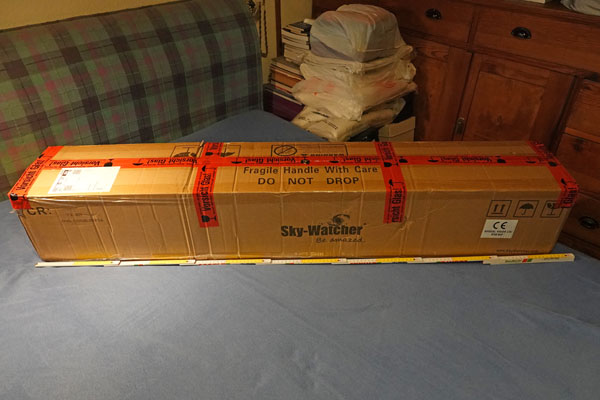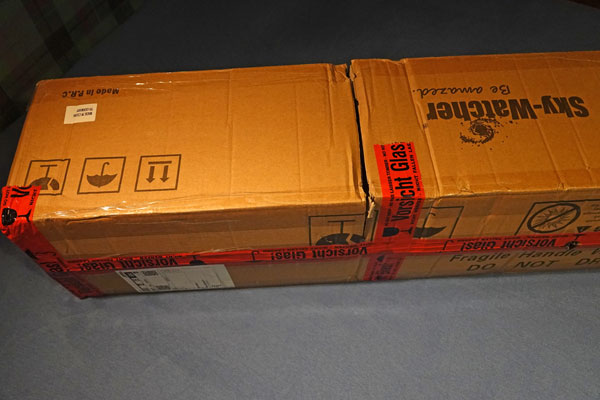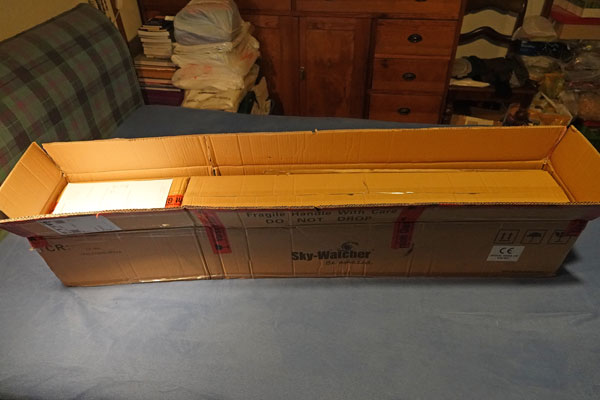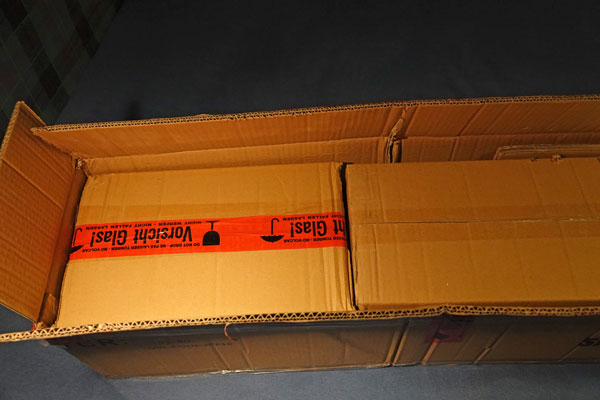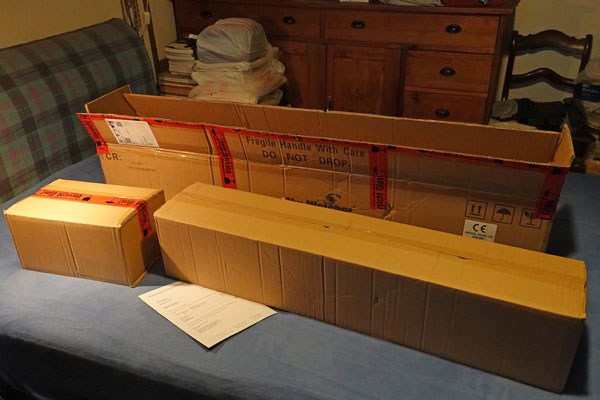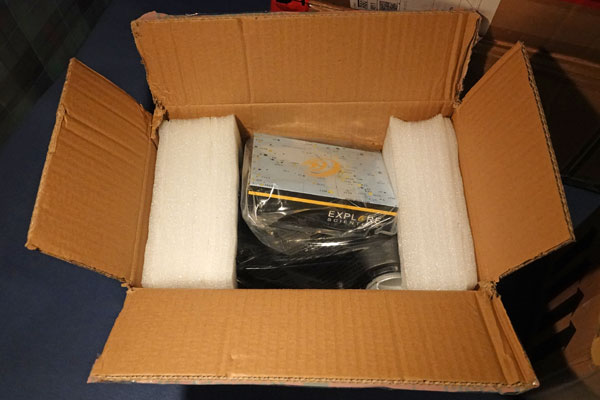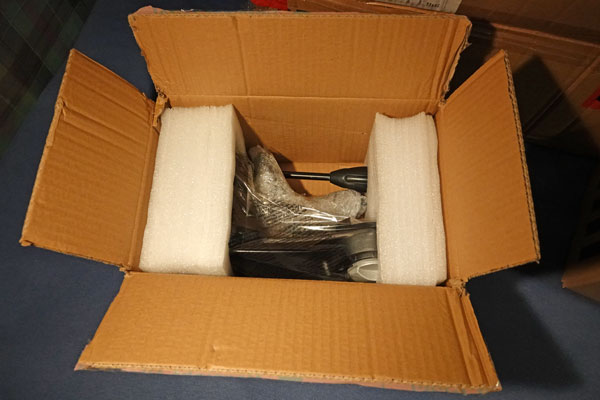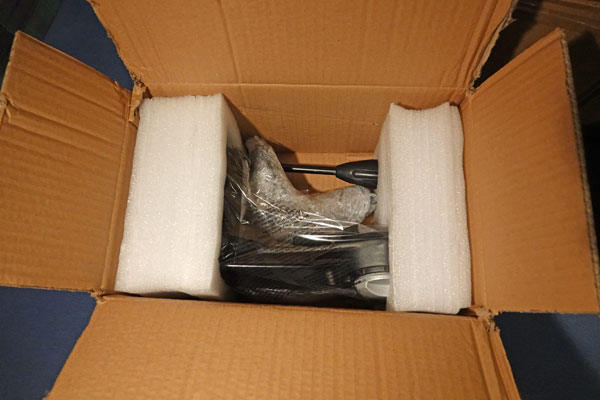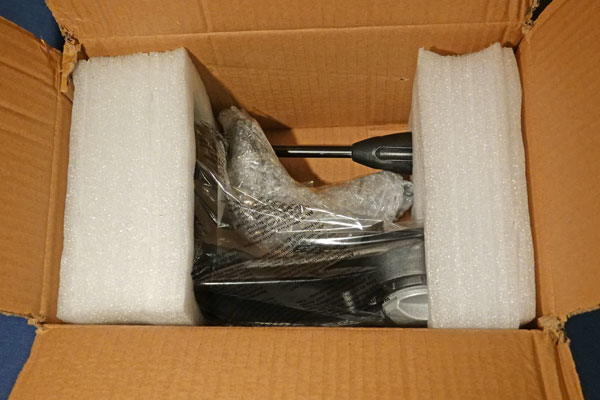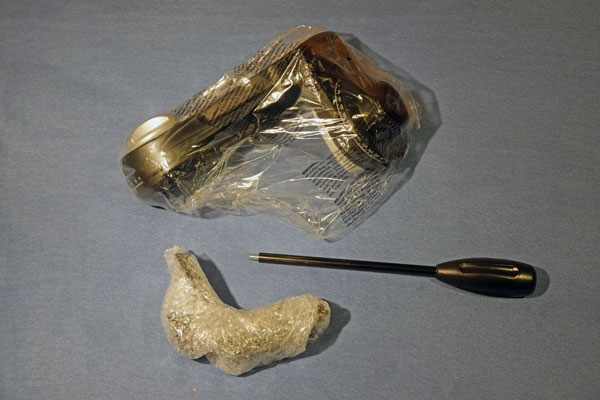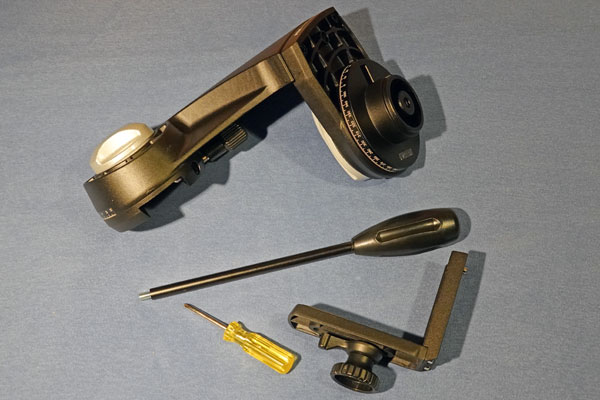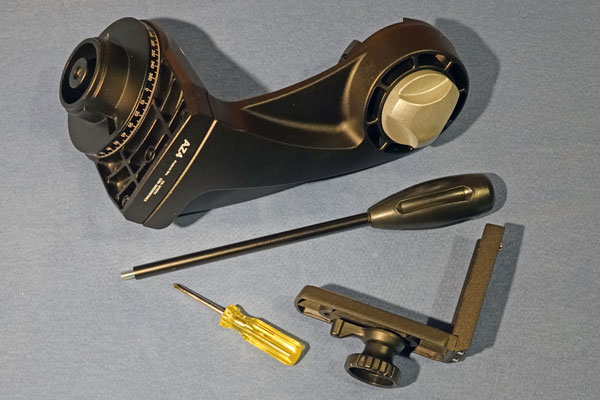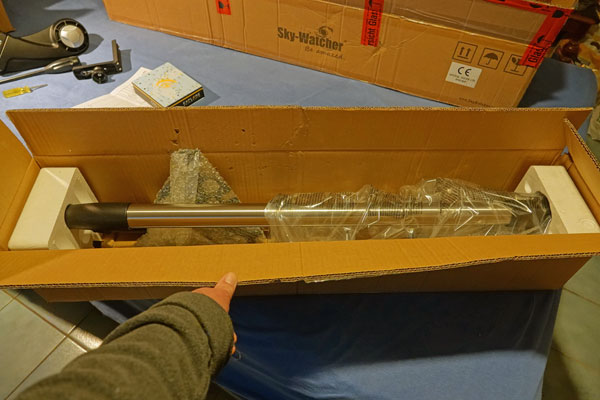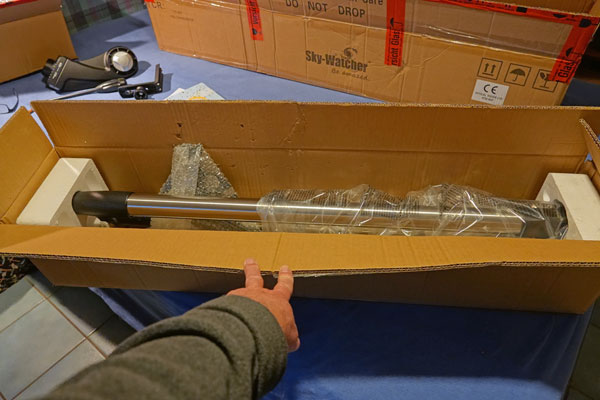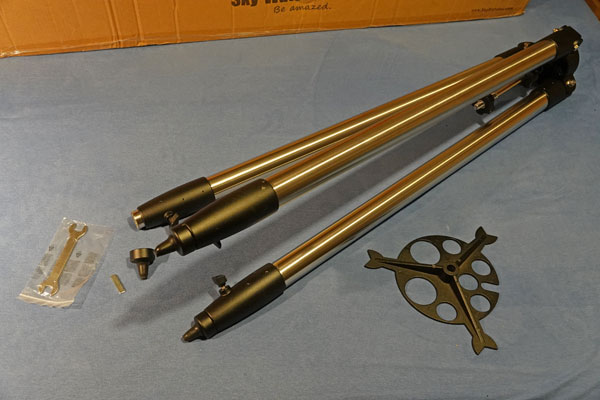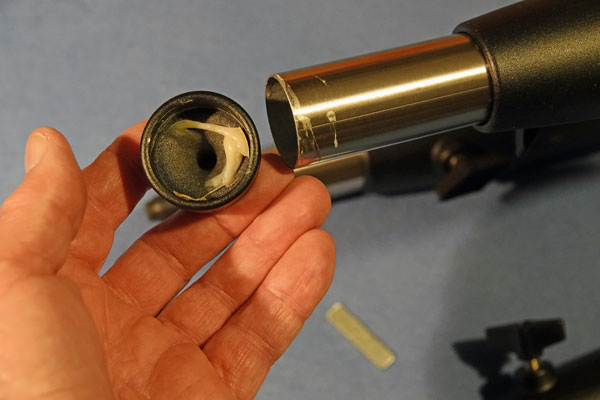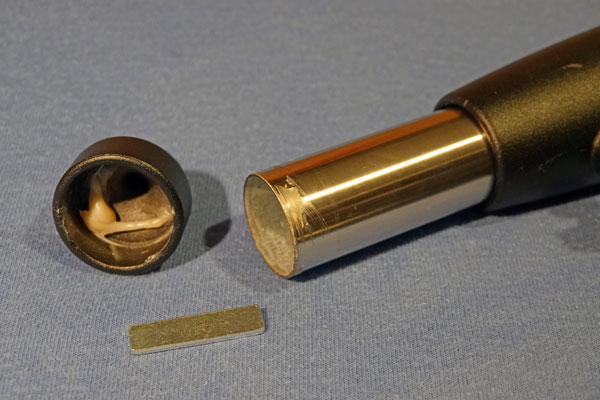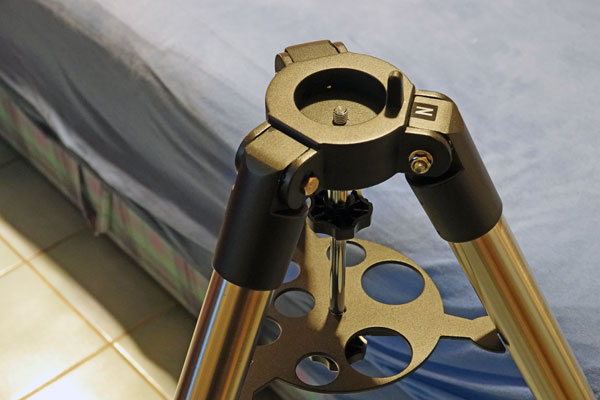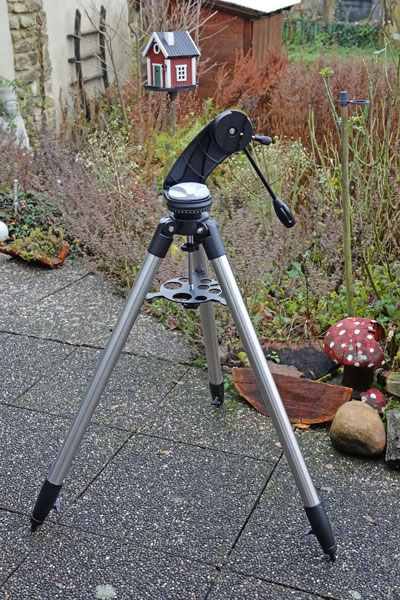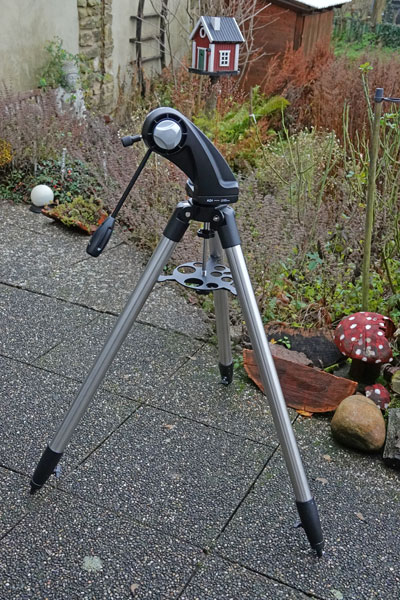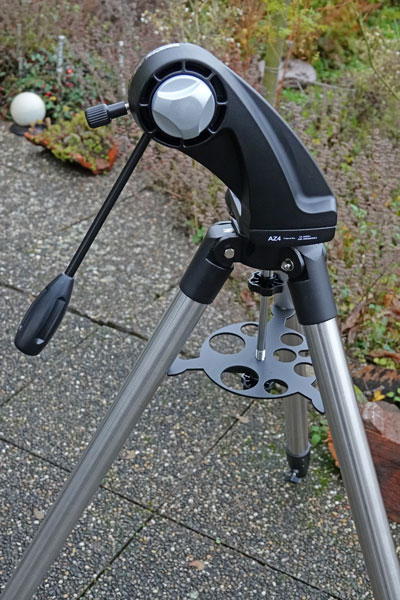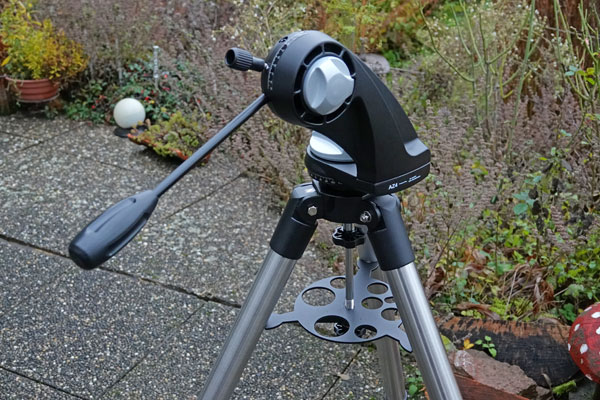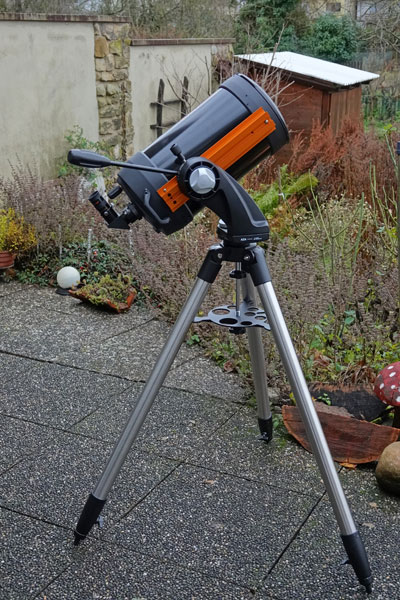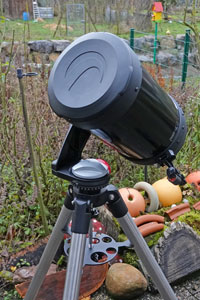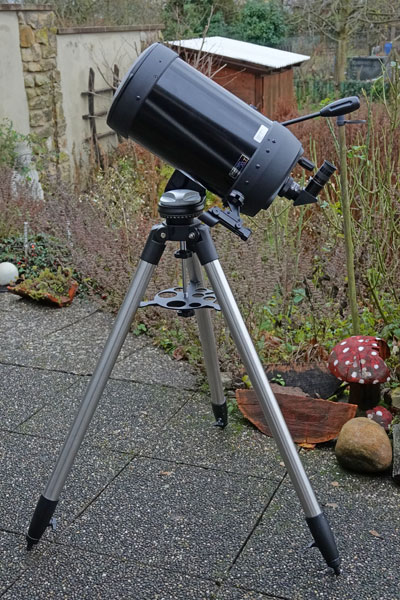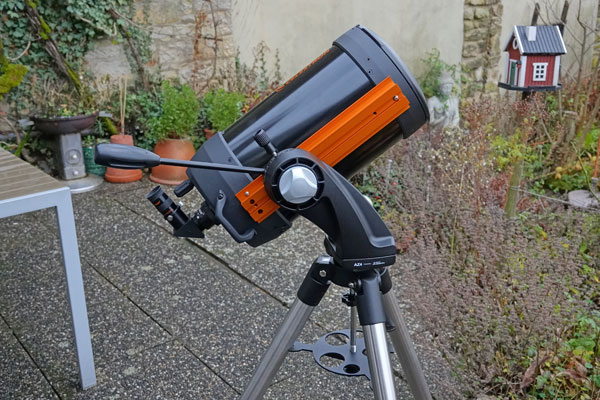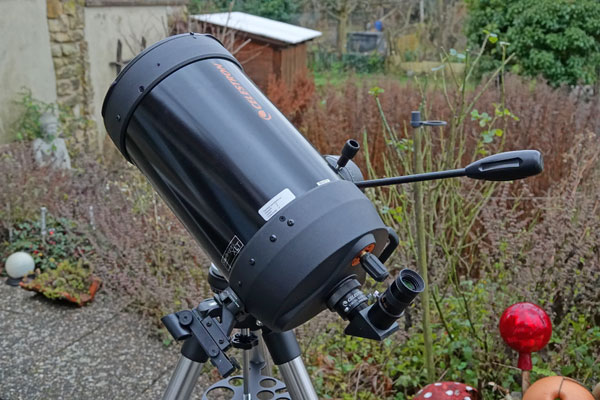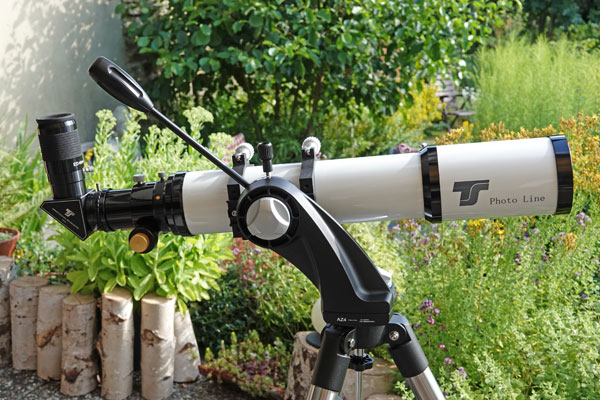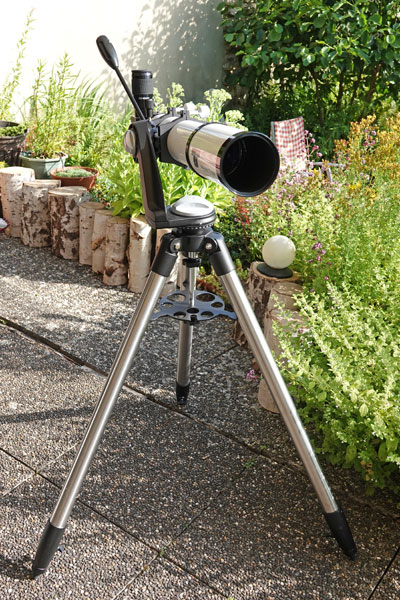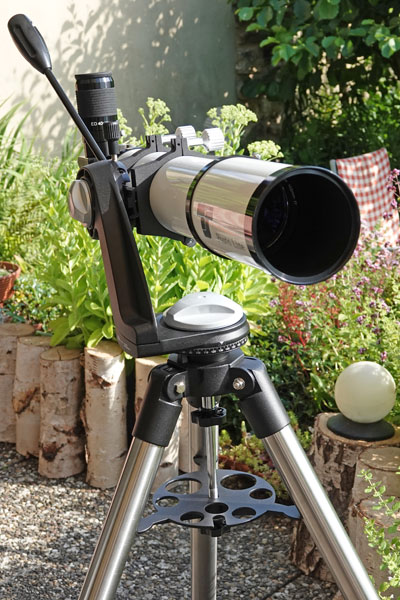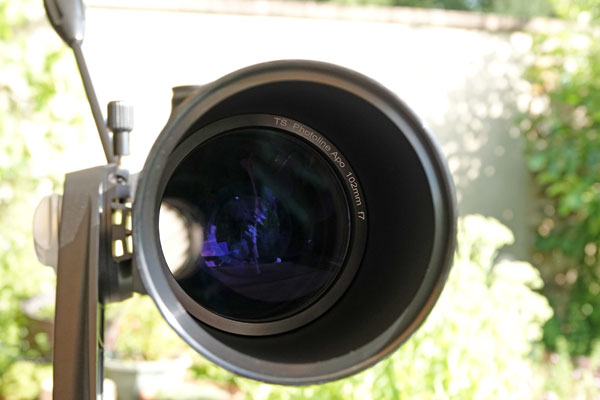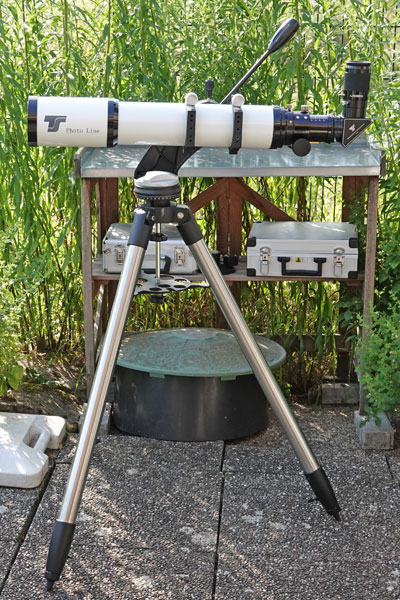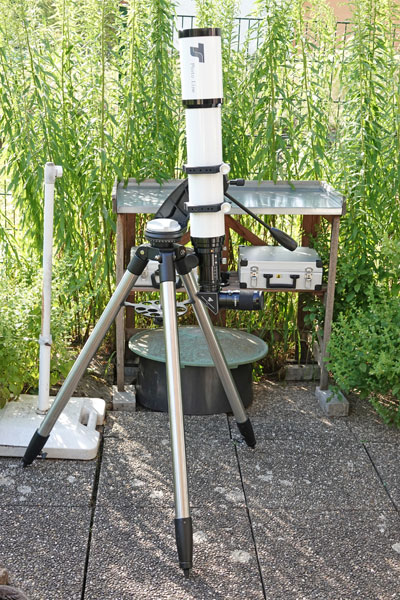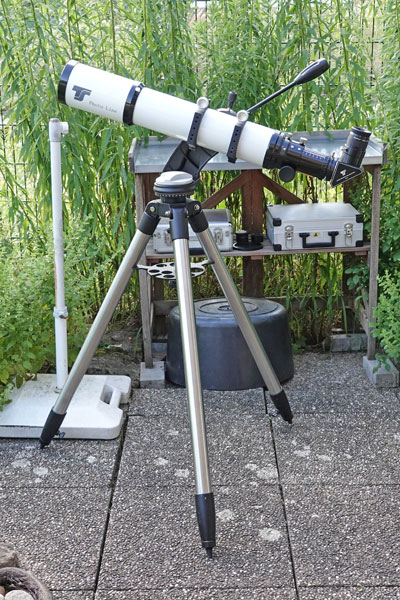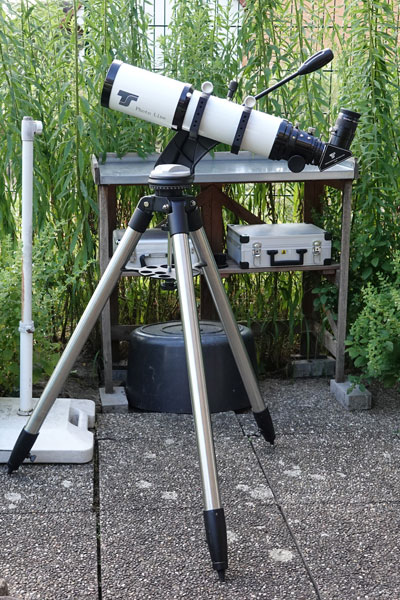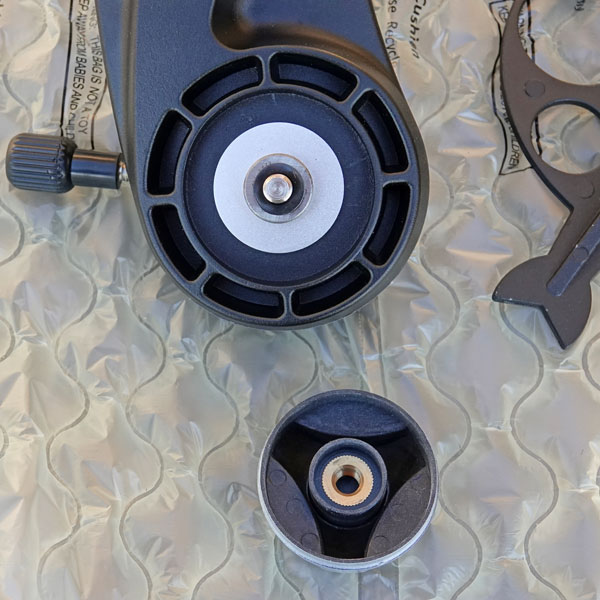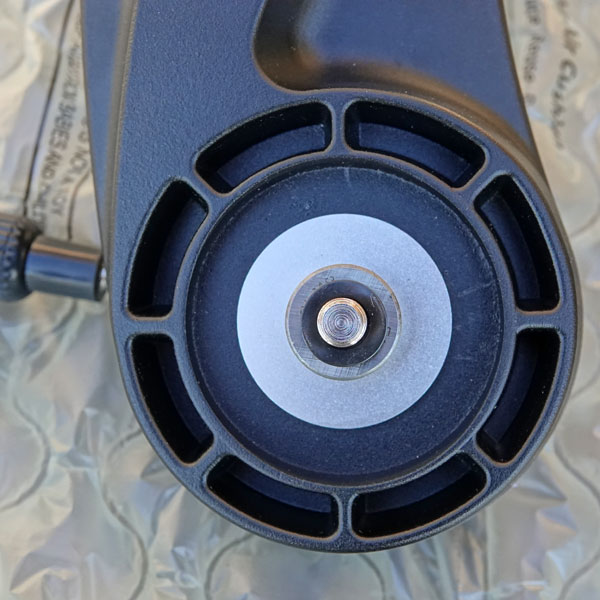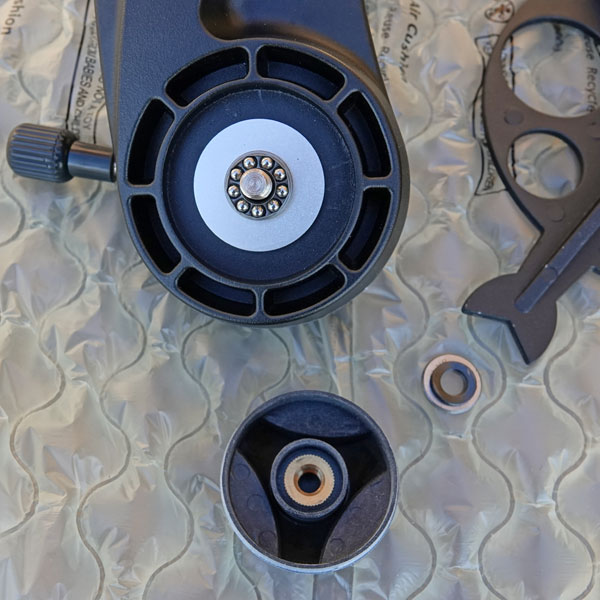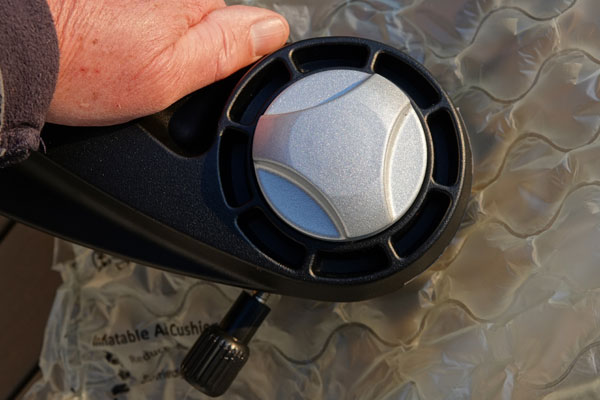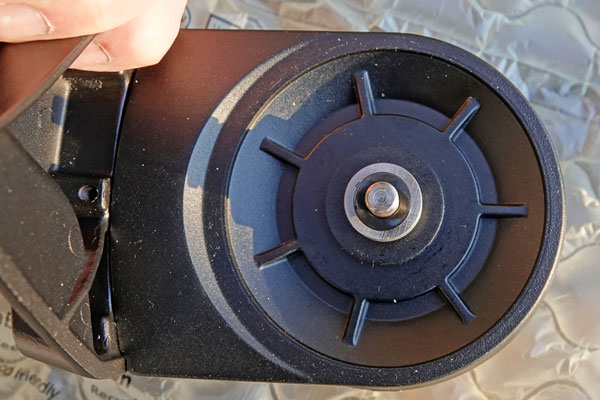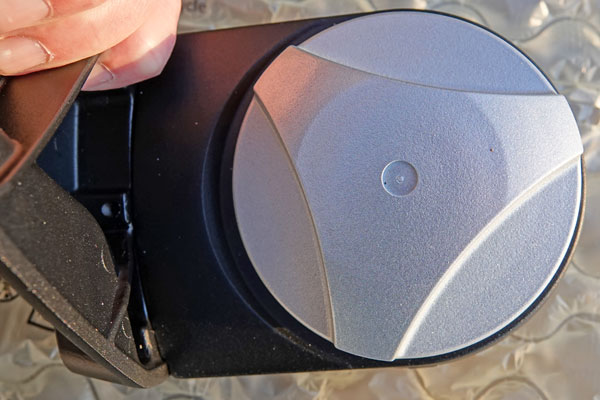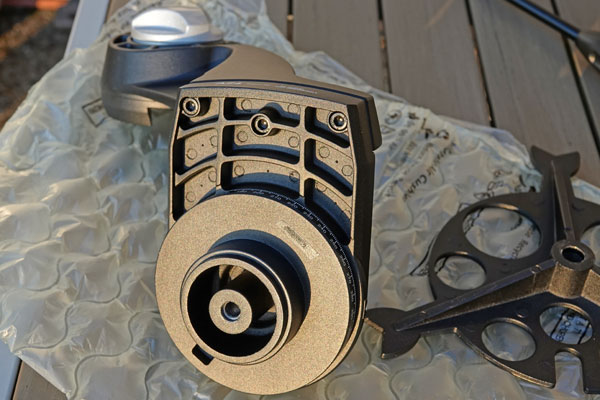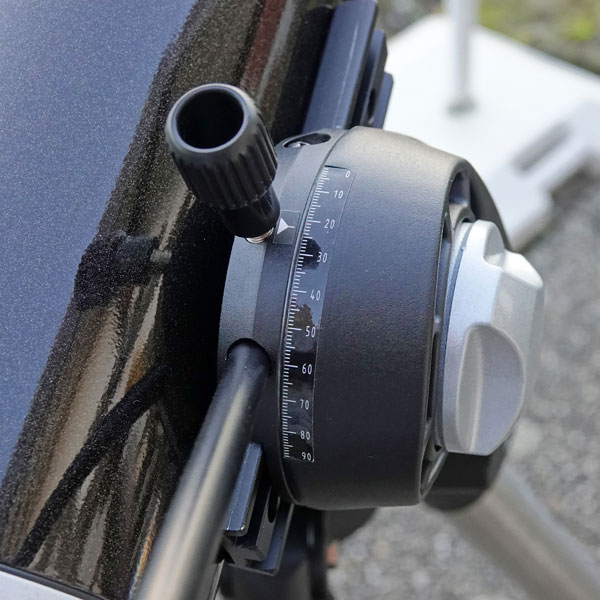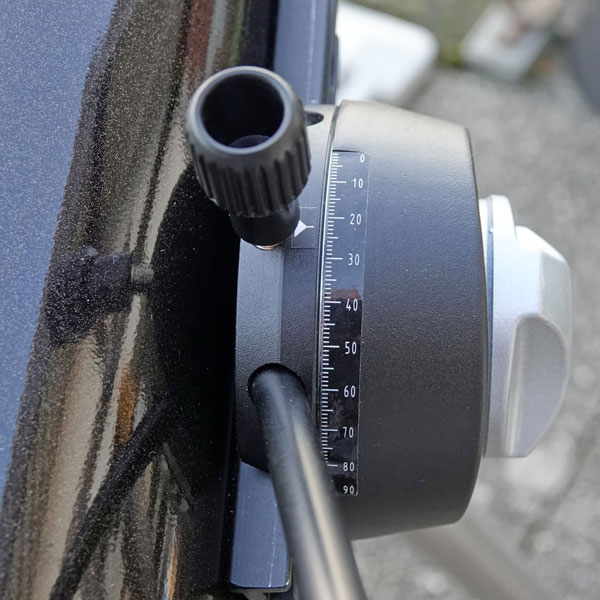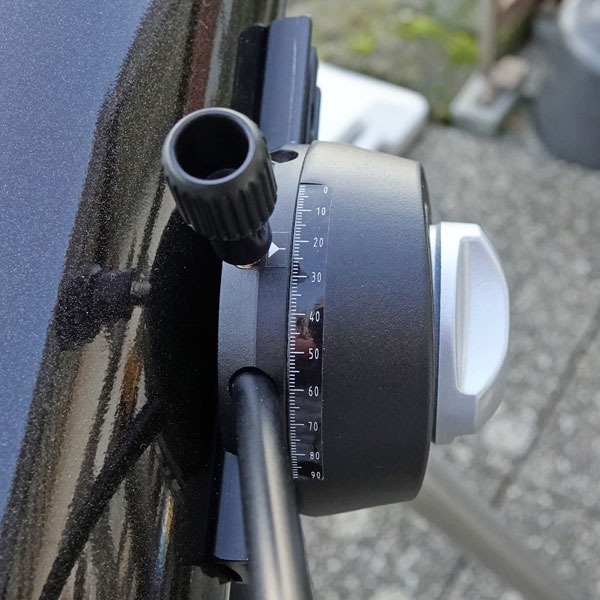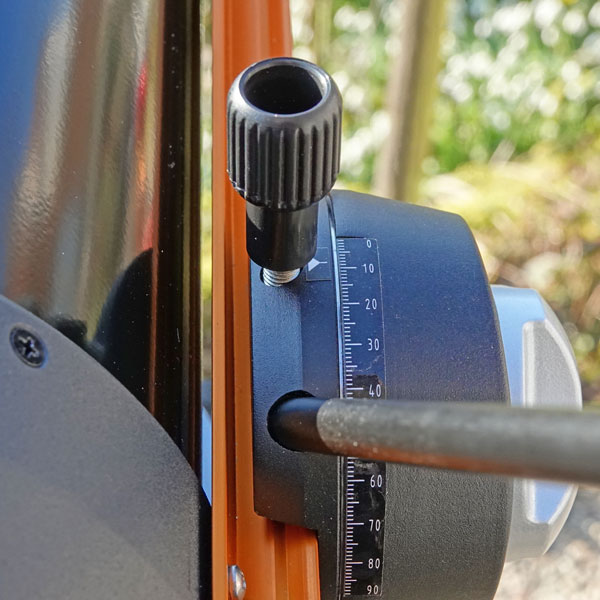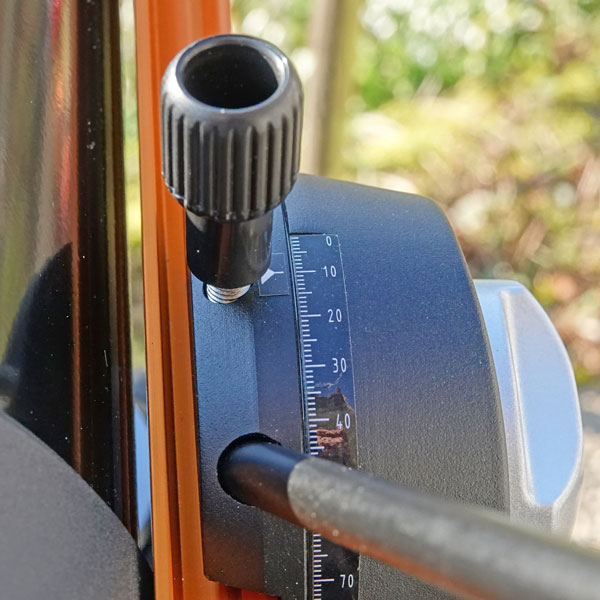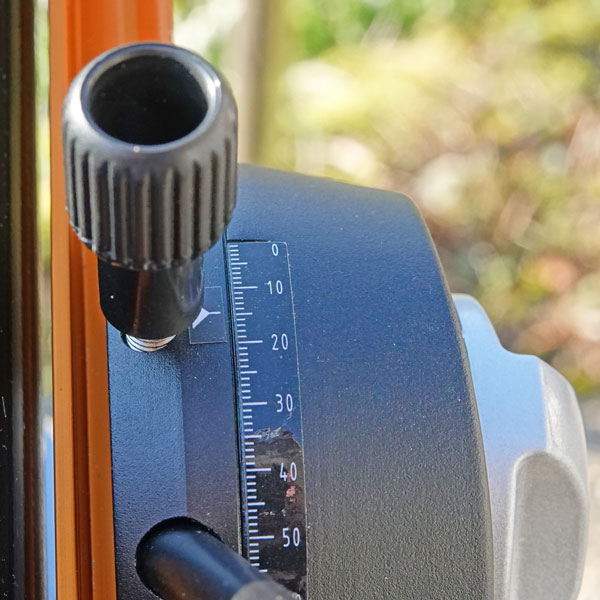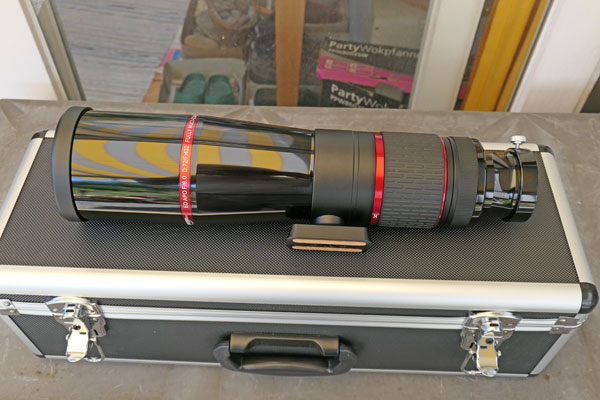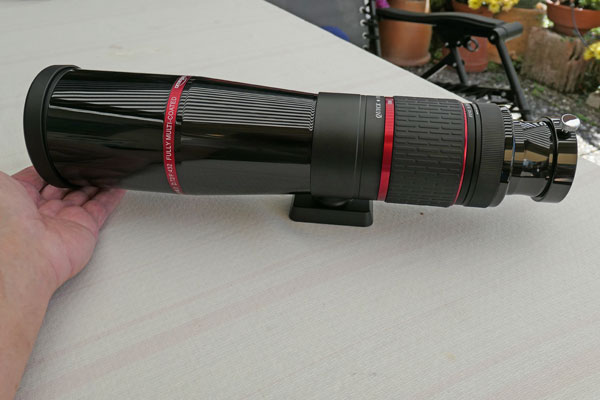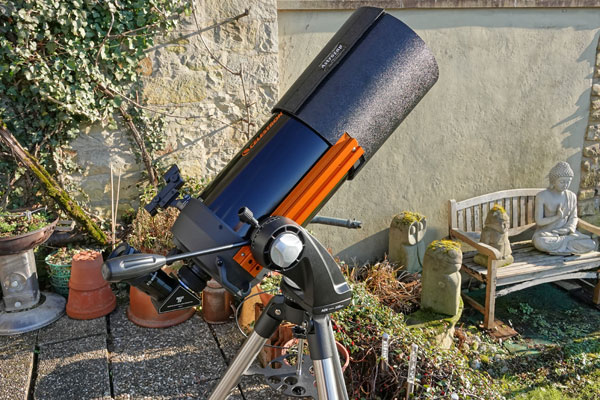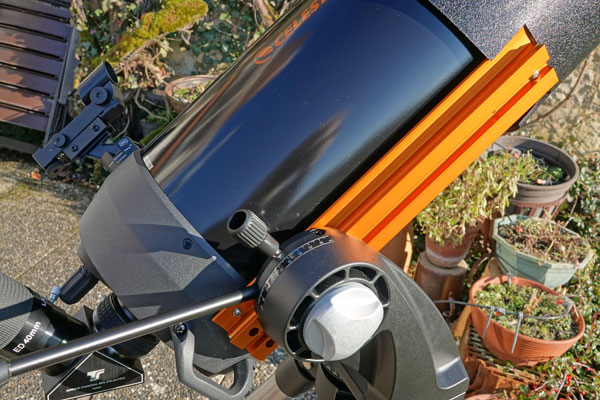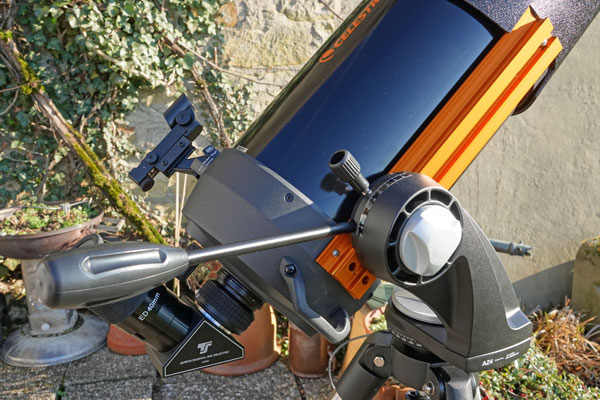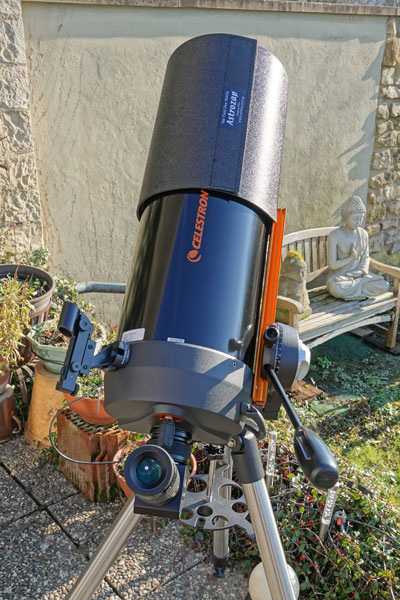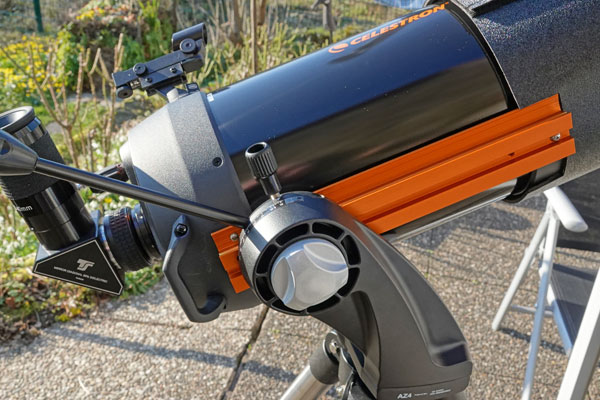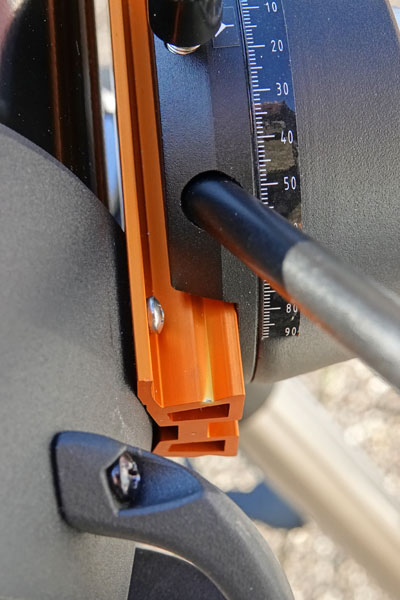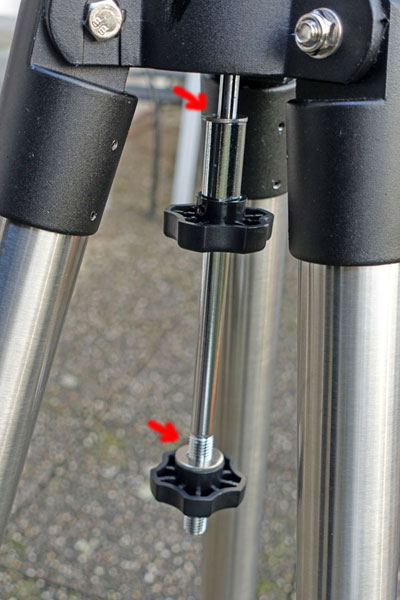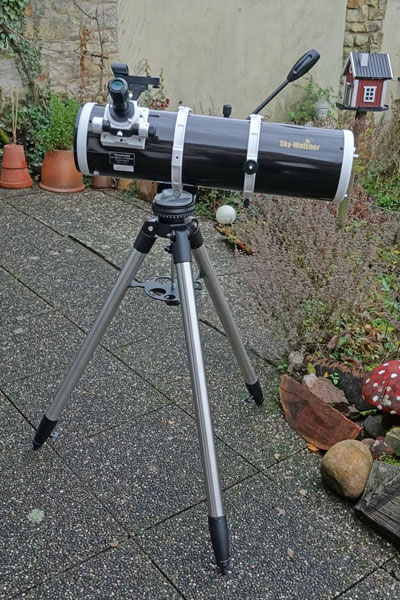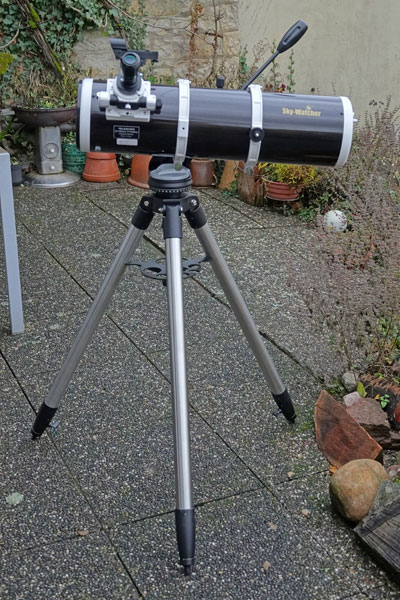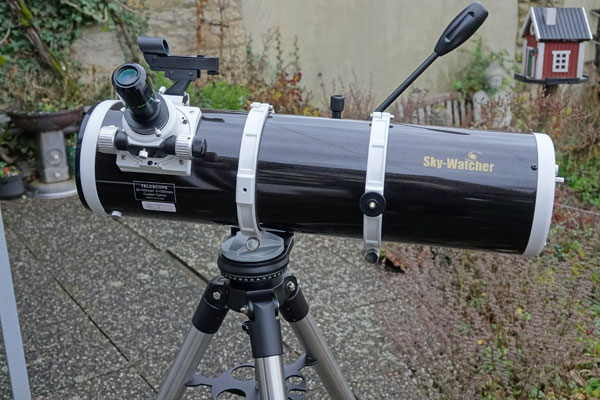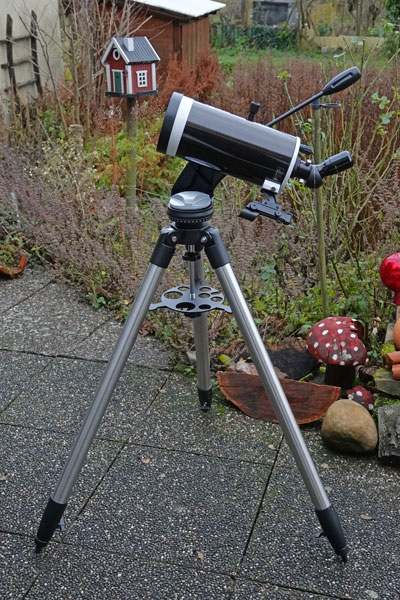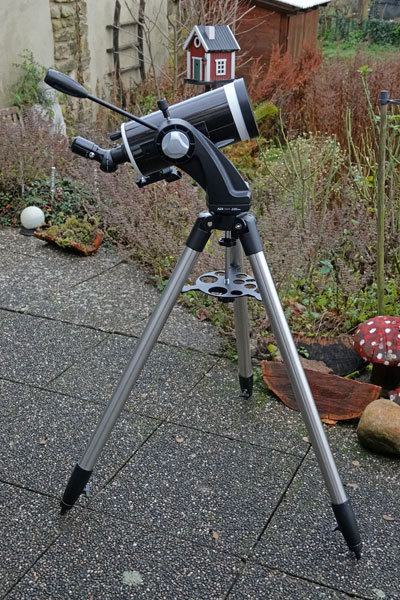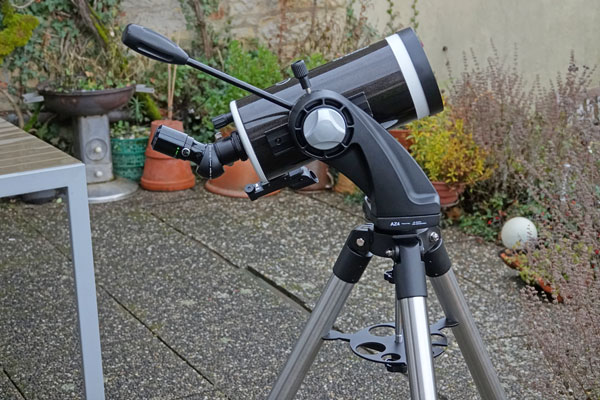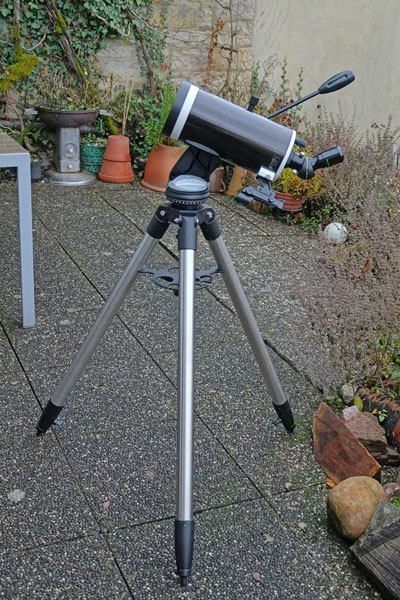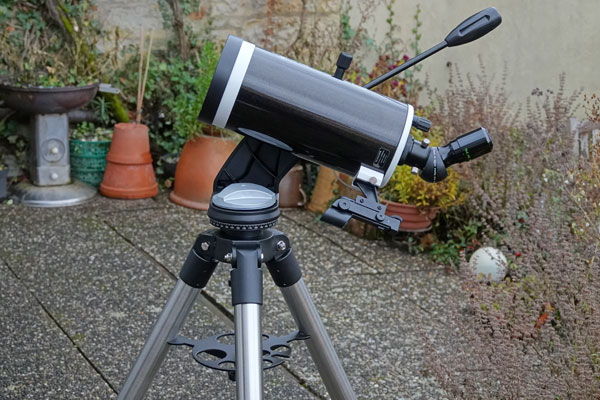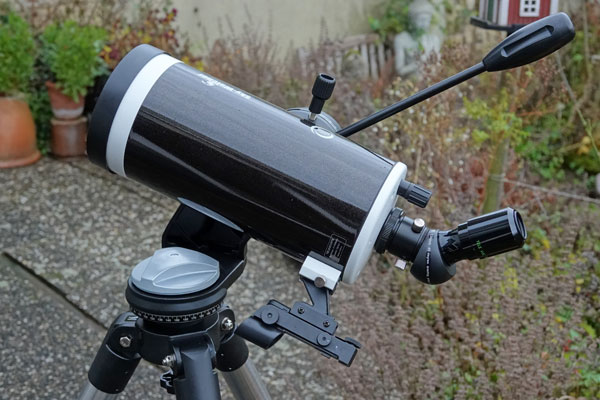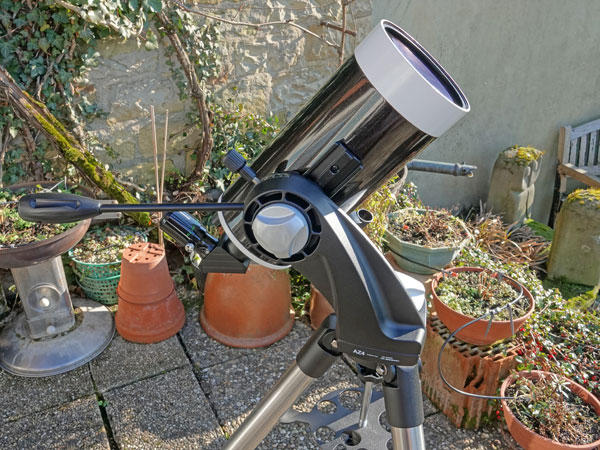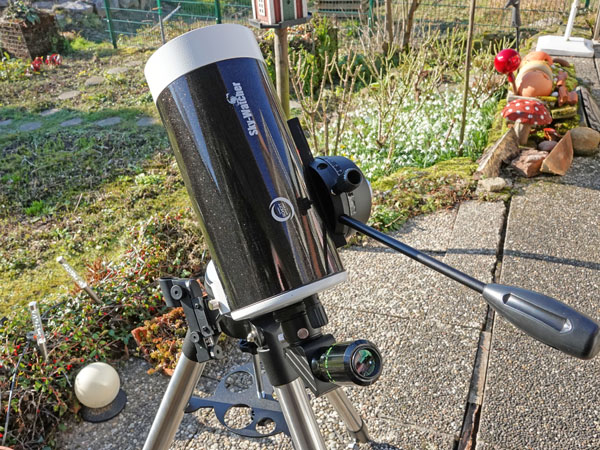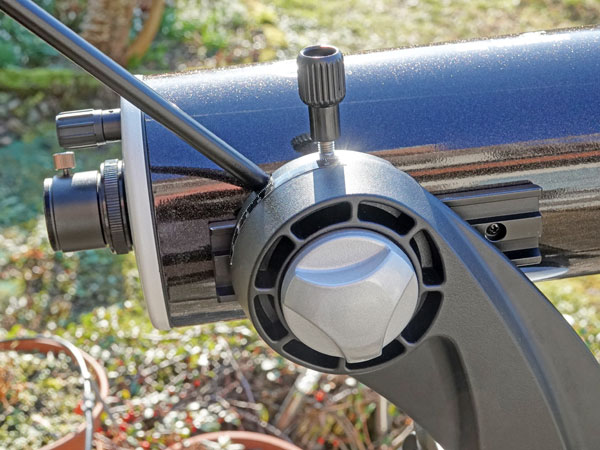Sky-Watcher AZ4 Mount Information
Motivation | Look | Look with Telescope Tubes | First Photo Attempts | First Experiences | First Conclusions | Links || Appendix: Data | Appendix 2: Look and Experiences with Previous Telescope Tubes
Archive
On this page, I present some information about my Sky-Watcher AZ4 telescope mount with stainless steel tripod (ordered on December 9, 2019, arrived on December 13, 2019).
On this mount I wanted to use my recently purchased Celestron C8 manually, whenever I want to start observing fast (otherwise, I use it on my Sky-Watcher Star Discovery mount). Of course, I can also use my other telescope tubes on it, because these are lighter. Together with the Star Discovery and the AZ Pronto mounts, I would now be able to operate three telescopes in parallel if necessary (for example, for comparison purposes).
| Note: Overall, I was not satisfied with the setup and operation of the AZ4 mount and ordered a GSO GSAZ mount in January 2021 that allows the use of flexible shafts (never received...). I sold the AZ4 at the end of May 2021 and therefore can no longer report on it. |
See the appendix for the technical data.
Motivation
Why did I buy the Sky-Watcher AZ4 mount and for what purpose? I mainly bought it to use my new Celestron C8, in addition to the motor operation on the Star Discovery mount, fast, powerless and without too much trembling on a simple AZ mount. According to my astronomy dealer Mr. Kloß, there is no alternative to this mount, at least in the lower price segment. According to the technical data, the AZ4 should be able to carry a weight of up to 8 kg. In the meantime, however, I have found a value of only 6.8 kg (15 lbs.) at the Sky-Watcher and Teleskop-Express Websites, which would be a "borderline" case with the C8 once again...
Of course, I can also use all my other telescope tubes on this mount, because
all of them are lighter than the C8. This would, at least, for the Explorer
150PDS be an alternative to the Star Discovery mount. The Skymax-127 is
also certainly better used on this mount than on the overloaded AZ-Pronto mount.
Update (Beginning of 2020): I sold the Explorer 150PDS at the end of
January 2020, so it is no longer available. In the meantime, I tested the PS72/432
refractor and the Skymax-127 on the AZ4 mount a bit more thoroughly. I found
out that the AZ4 mount is less recommendable for both tubes for different reasons.
More about this in my first experiences!
Update (February 2021):
At the end of January 2021, I also sold the Skymax-127. In the summer of 2020,
however, I acquired a larger refractor, the TLAPO1027 from TS-Optics. With
a similar weight as the C8, this refractor is another candidate for the AZ4...
Last, but not least, I now have three mounts at my disposal to be able to operate three telescopes in parallel, if necessary, for example to perform certain comparisons. In the long run, however, I hope to get more time for "real" observations and will perform fewer tests and comparisons (and have fewer changes in my equipment)...
Note: Overall, I was not satisfied with the setup and operation of the AZ4 mount and ordered a GSO GSAZ mount in January 2021 that allows the use of flexible shafts (never received...). I sold the AZ4 at the end of May 2021 and therefore can no longer report on it.
Look
Unpacking
|
Outer package |
Ditto, measuring nearly 1.4 m long |
Outer package damaged |
|
Outer package, opened |
Ditto |
Ditto; you can see that the inner boxes have different depths. This makes the outer packaging sensitive to lateral impacts; the crack is a little further to the right (back). |
|
Inner boxes taken out |
Smaller box opened, contains also a filter that I had ordered |
Ditto, filter taken out |
|
Ditto, closer view |
Ditto |
Box content still wrapped |
|
Ditto, unwrapped |
Ditto |
Large box opened (tripod) |
|
Ditto |
Tripod taken out of box, a foot got loose... |
Ditto |
|
Foot with glue remainders, closer view |
Ditto, a small metal part fell out of the tripod leg... Right: Foot put back in place (not glued)... |
Mount Assembled Partly and as a Whole...
|
Tripod from above without head |
Tripod complete |
Ditto, closer view |
|
Ditto, other side |
Ditto, closer view |
Ditto, oblique view from behind |
Look with Telescope Tubes
AZ4 Mount with Celestron C8 Tube
 |
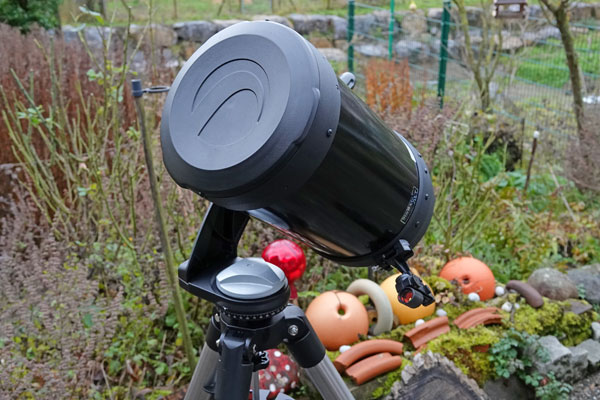 |
AZ4 Mount with PS 72/432 Refractor
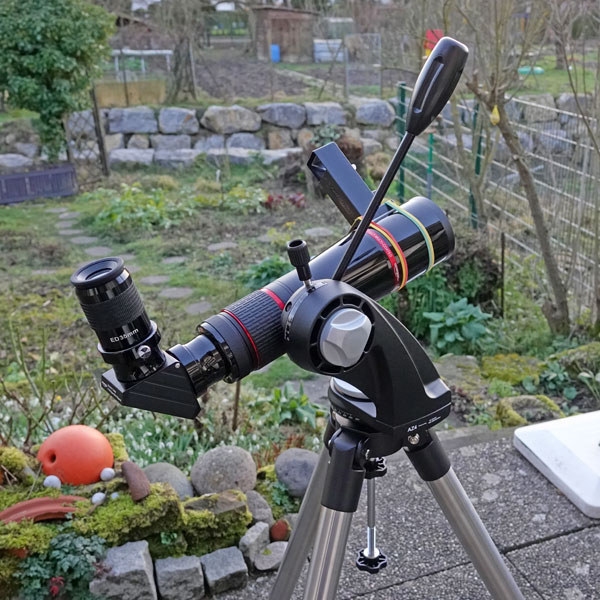 |
|
AZ4 Mount with TLAPO1027 Refractor
|
Horizontal, dew cap extended |
Vertical, dew cap extended |
Oblique, dew cap extended |
Ditto, dew cap retracted |
First Photo Attempts
Since photos can only be taken in cooperation with telescope tubes, I will show pictures on the pages of the respective telescopes, provided there should be any. Photos of the moon and of planets will primarily be shown in the respective sections for these sky objects.
First Experiences
A Look at the Axes...
|
Vertical (altitude) axis: Turning nut for the friction clutch removed; Turning nut at the bottom |
Ditto, closer view; two spring washers sit on top |
Ditto, spring washers and a washer that serves as counter bearing for the ball bearing removed |
|
Vertical (altitude) axis: Turning nut for the friction clutch back in place
|
Horizontal (azimuth) axis: Turning nut for the friction clutch removed; two spring washers sit on top |
Ditto, spring washers and a washer that serves as counter bearing for the ball bearing removed |
|
Horizontal (azimuth) axix: Turning nut for the friction clutch back in place |
Horizontal (azimuth) axis, bottom view |
|
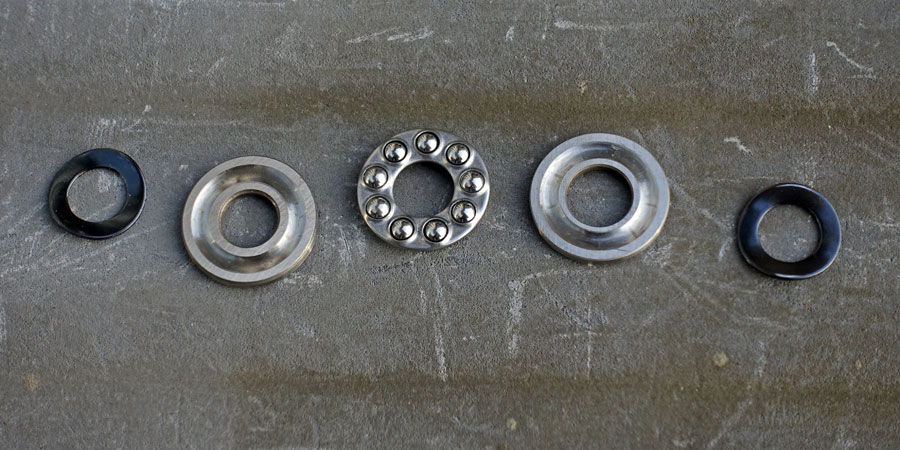 |
Left: Parts of the friction clutch (the two spring washers lie on top of each on the side of the turning nut) | |
Setting the Friction Clutches
Two large turning nuts (star screws) are used to adjust the slip clutches for the horizontal and vertical axes. The horizontal axis is uncritical, and you just should not tighten it too much, so that the axis does not jam - unless you want to lock this axis.
On the other hand, I find the friction clutch of the vertical axis to be difficult or even impossible to adjust, depending on the telescope. If you loosen the clutch of the vertical axis too much, a gap is formed and the telescope mount can tilt. Often, the axle then does no longer run "as smooth as butter" anymore (as the advertisement promises). If you loosen the coupling too far, the telescope might even fall down, but hopefully you will notice that in the dark in time...
|
Vertical (altitude) axis: If you look at the axis at an angle, you cannot see that a gap has formed. |
Here, a gap has formed by releasing the friction clutch too much, and you can see metal shining through; if you enlarge the gap, the telescope mount tilts. |
|
|
Ditto for the C8: the gap is too large, the mount starts to tilt |
This is probably about the maximum for the gap... |
This is better, hardly any gap visible |
In principle, you should balance the telescope as much as possible (the balance changes when you change eyepieces or other accessories) so that the tube stops and does not slip away in any position you put it in. How well this works also depends on the telescope. I cannot balance my refractor PS 72/432 because of its short prism foot, it always tilts backwards. So I always have to clamp the vertical axis if I want to keep it in a certain position. I can balance the Sky-Watcher Skymax-127 and the heavy C8 horizontally, but with the C8 there is no big difference between different positions at the rear end of the prism rail. Probably, the higher weight of the C8 plays a role (more friction). In horizontal position of the tube, both tubes can be moved on both axes almost "as soft as butter" with the swivel lever. However, if the tube is positioned fairly vertically, both tubes continue to move and have to be clamped more tightly, with the effect that the movement is no longer "as soft as butter". Especially at the beginning of the vertical movement, the static friction has to be overcome and there is a noticeable jump that can lead to losing your sky object. With the Skymax-127, I experienced that the tube, although it was balanced in the horizontal plane, moved in both directions when I tilted it! Strange, but that must have its reason in the changed load distribution...
I carried out these tests with the friction clutches during the day, and there is still a lack of experience regarding how both tubes perform in night-time practice. However, as I will explain below, I will only operate the Skymax-127 on the AZ4 mount in exceptional cases (namely, when the PS 72/432 is on the AZ-Pronto mount and I want to operate both tubes in parallel).
PS 72/432 on AZ4 Mount
 |
 |
Top: the short foot of the PS 72/432 Left/center: When the swivel arm is pointing forward, the tail-heaviness is reduced, but this is not enough for reaching balance |
Because of its short foot, the PS 72/432 refractor cannot be moved any further forward and is always "rear-heavy" on the AZ4 mount. Therefore, the vertical axis must always be clamped if the telescope is to remain in a certain position. Changing the direction of the swivel arm does not bring any noticeable improvement either. These are further reasons for me to use the PS 72/432 only on the AZ Pronto mount, especially since I prefer this mount anyway because of its flexible shafts.
C8 on AZ4 Mount
|
C8 on AZ4 mount, side view |
Ditto, detail of the prism rail, which is nearly at its end |
Ditto |
|
C8 on AZ4 mount, rear view |
C8 even more moved to the end of the prism rail |
Detail of the prism rail |
The C8 can just about be balanced on the AZ4 mount, with different positions at the end of the prism rail making no difference. The dew cap helps a little bit to adjust the balance. If the tube stands very steeply, it will not stop either, and the star screw must be tightened more firmly. As a consequence, the vertical axis does not run "as smooth as butter" anymore... The C8 certainly pushes the very robust AZ4 (with steel tripod) to its limits, but this combination still seems to be usable (depending on the source, the load capacity of the mount is 6.8 or 8 kg). In the end, the C8 is the telescope that I will mainly use on this mount - and that is why I bought it.
What I Find Annoying About the AZ4 Mount
|
The upper knurled screw gives me a lot of trouble when screwing it in and out. The arrows point to washers. The lower knurled screw... |
... ... holds the eyepiece rest which in turn stabilizes the tripod. |
Ditto |
For me, the most annoying aspect of the AZ4 mount is its assembly. Setting up the legs requires a lot of strength, because the joints are very stiff. The biggest trouble for me is, however, to screw in the long rod, which holds the mounting head, using a knurled screw. It takes me an eternity until the thread really grips. To make sure that the head is tight, I also have to tighten the screw very strongly - and then I have corresponding problems when I have to loosen it again when disassembling the mount. I also do not find the attachment of the eyepiece rest (which also stabilzes the tripod) very elegant, but I already know this from the Star Discovery mount...
First Conclusions
I bought the Sky-Watcher AZ4 mount to be able to use my new C8 tube on a manual mount. In addition, the new TLAPO1027 refractor is a candidate for this mount. Both is well possible, even though the assembly of the mount annoys me. The AZ4 mount seems to my impression very stable, even though it has certainly reached its limits with the C8. For my small telescopes, the AZ4 mount seems to be less suitable for the reasons I described above, and I will use them primarily on the the AZ-Pronto mount (I do no longer own the Skymax-127 and bought a C5 instead).
Overall, however, I was not satisfied with the setup and operation of the AZ4 mount and ordered a GSO GSAZ mount in January 2021 that allows the use of flexible shafts (never received...).
Note: I sold the AZ4 at the end of May 2021 and therefore can no longer report on it.
Links
- Sky-Watcher Company Website, USA: www.skywatcher.com
- Pages from German distributors for the Sky-Watcher AZ4 mount:
- Teleskop-Spezialisten (here I bought the mount): www.teleskop-spezialisten.de/shop/Telescope-Mounts/Azimuthal-mount-ALT-AZ/Skywatcher-AZ4-Azimuthal-mount-with-stainless-steel-tripod::897.html?language=en (stainless steel tripod) - www.teleskop-spezialisten.de/shop/Telescope-Mounts/Azimuthal-mount-ALT-AZ/AZ4-Skywatcher-AZ4-Azimuthal-mount-with-aluminum-tripod::408.html?language=en (Aluminium tripod)
- Astroshop: www.astroshop.eu/alt-azimuth-without-goto/skywatcher-mount-az-4-steel-tripod/p,16101 (stainless steel tripod) - www.astroshop.eu/alt-azimuth-without-goto/skywatcher-mount-az-4-aluminium-tripod/p,16100 (Aluminium tripod)
- Teleskop-Express: www.teleskop-express.de/shop/product_info.php/info/p5542_Skywatcher-AZ4---Alt-AZ-mount-with-stainless-steel-tripod.html (stainless steel tripod) - https://www.teleskop-express.de/shop/product_info.php/info/p3551_Skywatcher-AZ4---Alt-AZ-mount-with-aluminium-tripod.html (Aluminium tripod)
- See also my page offering Astronomy Links.
Appendix: Data for Sky-Watcher AZ4 Telescope Mount
Package Content
- Azimuthal AZ4 mount head with quick coupling
- Stainless steel or Aluminum tripod (stainless steel: diameter 1,75")
Data
- Shipping weight: 10 kg (stainless steel) / ? kg (Aluminum)
- Shipping size: 125 x 23 x 22 cm (stainless steel) / ? x ? x ? cm (Aluminum)
- Type: Azimuthal manual mount on tripod (stainless steel or Aluminum)
- Max. load visually: 8.00* kg (stainless steel) / ? kg (Aluminum) ; *) 6.80 according to Teleskop-Express and Sky-Watcher (15 lbs.)
- Max. load photographic: ditto
- Height adjustable by the tripod: from about 100 cm to 160 cm (stainless steel) / dito (Aluminum)
- Mount weight total: 8.4 kg (stainless steel) / 5.9 kg (Aluminum)
- Tripod weight: about 6 kg (like the AZ5 tripod)
- Mount head weight: about 2.4 kg (difference...or roughly 2.5 kg...)
Appendix 2: Look and Experiences with Previous Telescope Tubes
Note: I sold the AZ4 at the end of May 2021 and therefore can no longer report on it.
AZ4 Mount with Explorer 150PDS
Note: I sold the Explorer 150PDS at the end of January 2020.
AZ4 Mount with Skymax-102 OTA
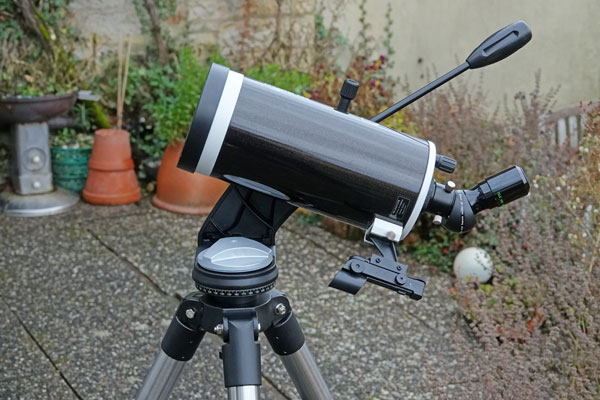 |
Note: I sold the Skymax-102 at the end of August 2018.
Skymax-127 on AZ4 Mount
|
Skymax-127 on AZ4 mount |
Ditto, other side; viewfinder in awkward position |
The swivel arm is close to the head when observing with the left eye |
|
Ditto |
Ditto, seen more from the back |
The prism rail just suffices for balancing the tube |
The Skymax 127 tube can be balanced on the AZ4 mount; the prism rail is just sufficient for this. In most cases, the tube can be moved easily and remains in position after releasing the swivel arm. However, if it stands quite vertical, the tube does not stop and tilts away. Often, tightening the vertical slip clutch helps, but then the movement becomes jerkier... The viewfinder is in a very unfavorable position due to the vertical mounting of the Skymax-127. All in all, I prefer to use the Skymax tube on the AZ-Pronto mount (even though it is a bit overloaded with this tube), if it is not occupied by my refractor... There the viewfinder has the correct position, and I prefer the flexible shafts of the AZ-Pronto.
Note: I sold the Skymax-127 at the end of January 2021.
| 24.06.2024 |

